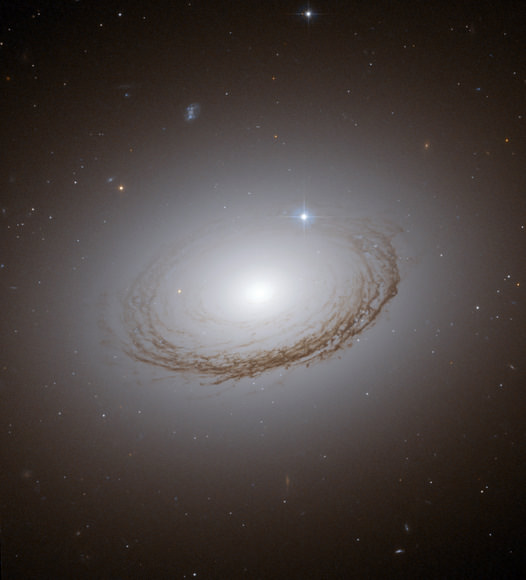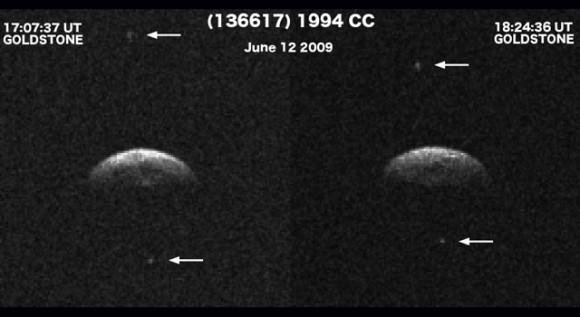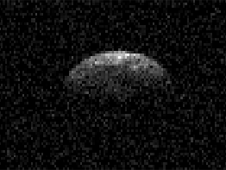~ASTRONOMY daily news~
- COSMOLOGIST
نام: محمد میرزایی
محل اقامت: تهران - شیراز
عضویت : سهشنبه ۱۳۸۵/۷/۱۸ - ۱۵:۳۷
پست: 4983-
سپاس: 153
- جنسیت:
تماس:
Re: ~ASTRONOMY daily news~
April 7th, 2009
Hubble Scores a Ring

The Hubble Space Telescope has captured a new image of NGC 7049, a mysterious looking galaxy that blurs the boundary between spiral and elliptical galaxies.
NGC 7049 is found in the constellation of Indus, and is the brightest of a cluster of galaxies, a so-called Brightest Cluster Galaxy. They represent some of the oldest and most massive galaxies, and they allow astronomers to study the elusive globular clusters lurking within.
Globular clusters are very dense and compact groupings of a few hundreds of thousands of young stars bound together by gravity. The globular clusters in NGC 7049 are seen as the sprinkling of small faint points of light in the galaxy’s halo. The halo – the ghostly region of diffuse light surrounding the galaxy – comprises myriad individual stars and provides a luminous background to the remarkable swirling ring of dust lanes surrounding NGC 7049’s core. The dust lanes, which appear as a lacy web, are dramatically backlit by the millions of stars in the halo of NGC 7049.
The image was taken by the Advanced Camera for Surveys on Hubble, which is optimised to hunt for galaxies and galaxy clusters in the remote and ancient Universe, at a time when our cosmos was very young.
The constellation of Indus, or the Indian, is one of the least conspicuous in the southern sky. It was named in the 16th century by Dutch astronomer Petrus Plancius from observations made by Dutch navigator Pieter Dirkszoon Keyser and Dutch explorer Frederick de Houtman.
Globular clusters are very dense and compact groupings of a few hundreds of thousands of young stars bound together by gravity. The globular clusters in NGC 7049 are seen as the sprinkling of small faint points of light in the galaxy’s halo. The halo – the ghostly region of diffuse light surrounding the galaxy – comprises myriad individual stars and provides a luminous background to the remarkable swirling ring of dust lanes surrounding NGC 7049’s core. The dust lanes, which appear as a lacy web, are dramatically backlit by the millions of stars in the halo of NGC 7049.
The image was taken by the Advanced Camera for Surveys on Hubble, which is optimised to hunt for galaxies and galaxy clusters in the remote and ancient Universe, at a time when our cosmos was very young.
The constellation of Indus, or the Indian, is one of the least conspicuous in the southern sky. It was named in the 16th century by Dutch astronomer Petrus Plancius from observations made by Dutch navigator Pieter Dirkszoon Keyser and Dutch explorer Frederick de Houtman.
Image credit: NASA, ESA and W. Harris (McMaster University, Ontario, Canada)

Caption: This picture, taken with a small ground-based camera, shows on its central-left portion the constellation of Indus, in the southern sky. Credit: A. Fujii
reference : universe today
- COSMOLOGIST
نام: محمد میرزایی
محل اقامت: تهران - شیراز
عضویت : سهشنبه ۱۳۸۵/۷/۱۸ - ۱۵:۳۷
پست: 4983-
سپاس: 153
- جنسیت:
تماس:
Re: ~ASTRONOMY daily news~
Near-Earth Object Has Two Moons

Radar images have shown that a near-Earth object is actually a triple system; an asteroid with two small moons. NASA's Goldstone Solar System Radar on June 12 and 14, 2009, revealed the new informaton about Asteroid 1994 CC. It came within 2.52 million kilometers (1.56 million miles) on June 10. Prior to the flyby, very little was known about this celestial body. 1994 CC is only the second triple system known in the near-Earth population. A team led by Marina Brozovic and Lance Benner, both scientists at NASA's Jet Propulsion Laboratory in Pasadena, Calif., made the discovery.

Caption: Asteroid 1994 CC encountered Earth within 2.52 million kilometers (1.56 million miles) on June 10. Prior to the flyby, very little was known about this celestial body. Image Credit: NASA/JPL/GSSR
1994 CC consists of a central object about 700 meters (2,300 feet) in diameter that has two smaller moons revolving around it. Preliminary analysis suggests that the two small satellites are at least 50 meters (164 feet) in diameter. Radar observations at Arecibo Observatory in Puerto Rico, led by the center's director Mike Nolan, also detected all three objects, and the combined observations from Goldstone and Arecibo will be utilized by JPL scientists and their colleagues to study 1994 CC's orbital and physical properties.
The next comparable Earth flyby for asteroid 1994 CC will occur in the year 2074 when the space rock trio flies past Earth at a distance of two-and-a-half million kilometers (1.6 million miles).
The next comparable Earth flyby for asteroid 1994 CC will occur in the year 2074 when the space rock trio flies past Earth at a distance of two-and-a-half million kilometers (1.6 million miles).
Of the hundreds of near-Earth asteroids observed by radar, only about 1 percent are triple systems
Re: ~ASTRONOMY daily news~
Feb. 10, 2009
NASA's Great Observatories Celebrate International Year of Astronomy
WASHINGTON -- Galileo first turned his telescope to the heavens in 1609, marking the dawn of modern astronomy. To commemorate 400 years of exploring the universe, 2009 has been designated the International Year of Astronomy.
In conjunction with Galileo's birthday on Feb. 15, NASA is releasing images from its Great Observatories -- the Hubble Space Telescope, Spitzer Space Telescope, and Chandra X-ray Observatory -- to more than 100 planetariums, museums, nature centers and schools across the country.
The selected sites will unveil a large 9-square-foot print of the spiral galaxy Messier 101 that combines the optical view of Hubble, the infrared view of Spitzer, and the X-ray view of Chandra into one multi-wavelength picture. "It's like using your eyes, night vision goggles and X-ray vision all at the same time," said Dr. Hashima Hasan, lead scientist for the International Year of Astronomy at NASA Headquarters in Washington.
Participating institutions also will display a matched trio of Hubble, Spitzer and Chandra images of Messier 101. Each image shows a different wavelength view of the galaxy that illustrates not only the different science each observatory conducts but also how far astronomy has come since Galileo.
Messier 101 is a spiral galaxy about 22 million light-years away in the constellation Ursa Major. It is larger than our own Milky Way galaxy but similar in many ways. Hubble's visible light view shows off the swirls of bright stars and glowing gas that give Messier 101 its nickname "the Pinwheel Galaxy." In contrast, Spitzer's infrared-light image sees into the spiral arms and reveals the glow of dust lanes where dense clouds can collapse to form new stars. Chandra's X-ray uncovers the high-energy features in the galaxy, such as remnants of exploded stars or matter zooming around black holes. The juxtaposition of observations from these three telescopes provides an in-depth view of the galaxy for both astronomers and the public.
"The amazing scientific discoveries Galileo made four centuries ago are continued today by scientists using NASA's space observatories," said Denise Smith, the unveiling's project manager at the Space Telescope Science Institute in Baltimore. "NASA's Great Observatories are distributing huge prints of spectacular images so the public can share in the exploration and wonder of the universe."
The unveilings will take place Feb. 14-28 at 76 museums and 40 schools and universities nationwide, reaching both big cities and small towns. Sites are planning celebrations involving the public, schools and local media.
The Astrophysics Division of NASA's Science Mission Directorate supports the International Year of Astronomy Great Observatories image unveiling. The project is a collaboration among the Space Telescope Science Institute, the Spitzer Science Center in Pasadena, Calif., and the Chandra X-ray Center in Cambridge, Mass.
In conjunction with Galileo's birthday on Feb. 15, NASA is releasing images from its Great Observatories -- the Hubble Space Telescope, Spitzer Space Telescope, and Chandra X-ray Observatory -- to more than 100 planetariums, museums, nature centers and schools across the country.
The selected sites will unveil a large 9-square-foot print of the spiral galaxy Messier 101 that combines the optical view of Hubble, the infrared view of Spitzer, and the X-ray view of Chandra into one multi-wavelength picture. "It's like using your eyes, night vision goggles and X-ray vision all at the same time," said Dr. Hashima Hasan, lead scientist for the International Year of Astronomy at NASA Headquarters in Washington.
Participating institutions also will display a matched trio of Hubble, Spitzer and Chandra images of Messier 101. Each image shows a different wavelength view of the galaxy that illustrates not only the different science each observatory conducts but also how far astronomy has come since Galileo.
Messier 101 is a spiral galaxy about 22 million light-years away in the constellation Ursa Major. It is larger than our own Milky Way galaxy but similar in many ways. Hubble's visible light view shows off the swirls of bright stars and glowing gas that give Messier 101 its nickname "the Pinwheel Galaxy." In contrast, Spitzer's infrared-light image sees into the spiral arms and reveals the glow of dust lanes where dense clouds can collapse to form new stars. Chandra's X-ray uncovers the high-energy features in the galaxy, such as remnants of exploded stars or matter zooming around black holes. The juxtaposition of observations from these three telescopes provides an in-depth view of the galaxy for both astronomers and the public.
"The amazing scientific discoveries Galileo made four centuries ago are continued today by scientists using NASA's space observatories," said Denise Smith, the unveiling's project manager at the Space Telescope Science Institute in Baltimore. "NASA's Great Observatories are distributing huge prints of spectacular images so the public can share in the exploration and wonder of the universe."
The unveilings will take place Feb. 14-28 at 76 museums and 40 schools and universities nationwide, reaching both big cities and small towns. Sites are planning celebrations involving the public, schools and local media.
The Astrophysics Division of NASA's Science Mission Directorate supports the International Year of Astronomy Great Observatories image unveiling. The project is a collaboration among the Space Telescope Science Institute, the Spitzer Science Center in Pasadena, Calif., and the Chandra X-ray Center in Cambridge, Mass.
A list of places exhibiting these images can be found at:
http://hubblesource.stsci.edu/events/iy ... ipants.phpFind out more about NASA's contributions to the International Year of Astronomy at:
كتاب طبيعت با نمادهای رياضی نوشته شده است.
Galileo Galilei
Galileo Galilei
Re: ~ASTRONOMY daily news~
Massive Attack

Image Credits: X-ray: NASA/CXC/KIPAC/N. Werner et al Radio: NSF/NRAO/AUI/W. Cotton
This image shows the eruption of a galactic “super-volcano” in the massive galaxy M87, as witnessed by NASA's Chandra X-ray Observatory and NSF's Very Large Array (VLA). At a distance of about 50 million light years, M87 is relatively close to Earth and lies at the center of the Virgo cluster, which contains thousands of galaxies.
The cluster surrounding M87 is filled with hot gas glowing in X-ray light (and shown in blue) that is detected by Chandra. As this gas cools, it can fall toward the galaxy'scenter where it should continue to cool even faster and form new stars.However, radio observations with the VLA (red) suggest that in M87 jets of very energetic particles produced by the black hole interrupt this process. These jets lift up the relatively cool gas near the center of the galaxy and produce shock waves in the galaxy's atmosphere because of their supersonic speed. The interaction of this cosmic “eruption” with the galaxy's environment is very similar to that of the Eyjafjallajokull volcano in Iceland that occurred in 2010. With Eyjafjallajokull, pockets of hot gas blasted through the surface of the lava, generating shock waves that can be seen passing through the grey smoke of the volcano. This hot gas then rises up in the atmosphere, dragging the dark ash with it. This process can be seen in a movie of the Eyjafjallajokullvolcano where the shock waves propagating in the smoke are followed by the rise of dark ash clouds into the atmosphere.In the analogy with Eyjafjallajokull, the energetic particles produced in the vicinity of the black hole rise through the X-ray emitting atmosphere of the cluster, lifting up the coolest gas near the center of M87 in their wake. This is similar to the hot volcanic gases drag up the clouds of dark ash. And just like the volcano here on Earth, shockwaves can be seen when the black hole pumps energetic particles into the cluster gas.
The cluster surrounding M87 is filled with hot gas glowing in X-ray light (and shown in blue) that is detected by Chandra. As this gas cools, it can fall toward the galaxy'scenter where it should continue to cool even faster and form new stars.However, radio observations with the VLA (red) suggest that in M87 jets of very energetic particles produced by the black hole interrupt this process. These jets lift up the relatively cool gas near the center of the galaxy and produce shock waves in the galaxy's atmosphere because of their supersonic speed. The interaction of this cosmic “eruption” with the galaxy's environment is very similar to that of the Eyjafjallajokull volcano in Iceland that occurred in 2010. With Eyjafjallajokull, pockets of hot gas blasted through the surface of the lava, generating shock waves that can be seen passing through the grey smoke of the volcano. This hot gas then rises up in the atmosphere, dragging the dark ash with it. This process can be seen in a movie of the Eyjafjallajokullvolcano where the shock waves propagating in the smoke are followed by the rise of dark ash clouds into the atmosphere.In the analogy with Eyjafjallajokull, the energetic particles produced in the vicinity of the black hole rise through the X-ray emitting atmosphere of the cluster, lifting up the coolest gas near the center of M87 in their wake. This is similar to the hot volcanic gases drag up the clouds of dark ash. And just like the volcano here on Earth, shockwaves can be seen when the black hole pumps energetic particles into the cluster gas.
reference = NASA
كتاب طبيعت با نمادهای رياضی نوشته شده است.
Galileo Galilei
Galileo Galilei


